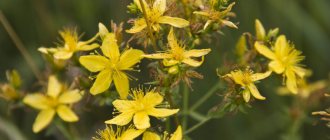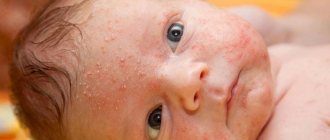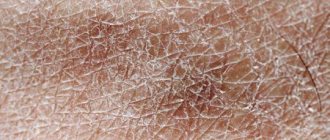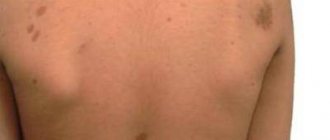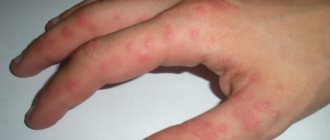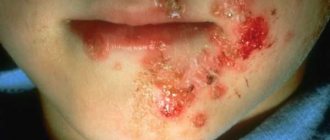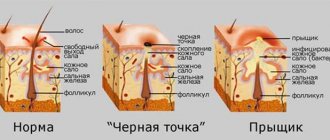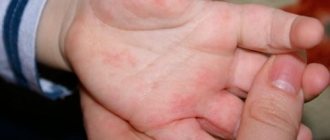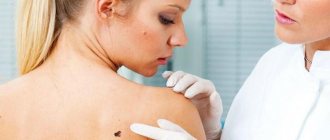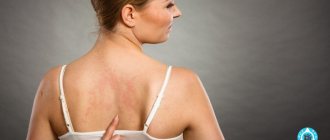There are many reasons for acne on the hands. They can be a secondary sign of the disease or its main symptom, located in several places or be isolated. In some cases, acne affects the entire arm or just the hand and wrist. First of all, you need to determine the cause of the problem, and only then take any measures.
Excessive sweating
In stressful situations, overwork or metabolic disorders, some people experience sweaty palms. If the disease, which is medically called hyperhidrosis, is not treated, then rashes can be found on the skin.
Increased sweating not only creates inconvenience for a person. This causes the development of pathogenic bacteria, which are found in a humid environment favorable to them. When they penetrate through microcracks in the hands, the development of an inflammatory process begins.
Allergy
Rashes often appear as a result of contact allergies. Symptoms can be detected after a person touches or consumes the irritant.
These may be:
- household chemicals;
- toxic substances;
- food products;
- animal hair;
- dust.
The allergic reaction is accompanied by severe itching. Rashes are especially common in people who do not use rubber gloves when cleaning.
If there is contact between the allergen and the skin, red and white pimples may appear on the palms and in the forearm area. They are small in size.
Often the rash is not limited to the extremities. They spread throughout the body. They itch very much and cause various inconveniences to humans.
Sycosis
The disease more often affects men; neuroendocrine disorders are considered to be the provoking factor. Its formation is often associated with chronic rhinitis and conjunctivitis. The main areas of localization of ulcers are:
- nasal mucosa,
- chin skin,
- area above the upper lip,
- nose wings,
- brows,
- eyelids,
- pubic area.
Often the formation of ulcers is observed on the scalp of the face. The first symptoms are the appearance of hyperemia - the formation of grouped pustules that contain pus in their cavity. This process is called folliculitis, it spreads to adjacent areas, first affecting the superficial layers of the skin.
Disorders of the gastrointestinal tract
The gastrointestinal tract performs an important excretory function in the body. If the functioning of the digestive system is disrupted, toxins can be released through the skin. As a result, multiple rashes appear on the face, body, including the hands. Such changes lead to:
- gastritis;
- intestinal disorder;
- dysbiosis.
Improper nutrition can also cause problems.
Chickenpox
In childhood, acne on the palms may appear during the period of chickenpox. The rashes are presented in the form of bubbles filled with transparent contents. The patient experiences severe itching and increased body temperature.
It is strictly forbidden to scratch pimples. They can be injured, and after recovery, ugly scars will remain on the skin.
Fungus
Fungal infections are often observed in the nail area and on the fingers around them. However, if left untreated, microorganisms can spread through cracks in the skin and over the palm area.
The fungus is characterized by red pimples and flaking skin. The patient also notes severe itching. You can get rid of rashes only with antifungal therapy.
Enterovirus infection
The causes of acne on the palms may be associated with damage to the body by enterovirus infection. It manifests itself in the form of small rashes all over the body, including on the hands. In some patients, formations form even in the oral cavity.
The appearance of enterovirus can be distinguished by several signs.
- Red spots or small blistering rashes form on the skin.
- When the body is damaged, there is a sharp increase in body temperature.
- The formations on the skin do not itch. But at the same time the patient feels pain.
Scabies
Severe itching and rashes on the palms may indicate that scabies mites have entered the body. In this case, grayish stripes appear on the fingers.
Heredity and other factors
The cause of rashes may also be heredity. There are many diseases of this nature, but the most common of them are:
- psoriasis;
- Darier's disease;
- pathologies associated with excessive sebum production.
In this case, the rash appears on the skin regularly, and despite treatment efforts, it returns again and again. It can be located only on the arms in the vein area or spread to the back, chest and even the whole body. Unfortunately, these diseases cannot be cured, only their course can be alleviated.
There are other reasons. For example, a rash on a child’s hands may indicate poor hygiene. If dirt gets into even a small wound, inflammation in the form of acne may appear. You need to teach your child to wash their hands thoroughly.
In adults, red pimples on the hands may appear due to stress. Nervous stress leads to the appearance of a rash similar to an allergic one. In such a situation, complex therapy will be required.
It is very important to separately note especially dangerous viral diseases, which are characterized by rashes on the hands. There are two such diseases, but everyone should know about them:
- Streptoderma. It occurs when streptococcus enters the layers of the skin and penetrates through any cut or wound on the body. A characteristic feature of the rash is that it is small and transparent, and there is liquid inside the pimple. All this is accompanied by itching and deterioration of the general condition. The disease is highly contagious and also fraught with complications. With reduced immunity, the heart, blood vessels and joints suffer.
- Neurodermatitis. This is a chronic disease that is neuro-allergic in nature. There are several types of the disease, which differ in the location of acne and their appearance. The peculiarity of the pathology is that it is chronic and cannot be completely cured. The disease practically does not go away, in most cases only remission is possible.
Treatment of rashes
Single pimples are usually not serious. They go away on their own and therefore do not require treatment. But if subcutaneous formations or purulent lesions are detected, you should definitely consult a doctor. He must select therapy in accordance with the diagnosis.
Most often, rashes are the result of an allergic reaction or infection.
In this case, you will need to take:
- antihistamines Zyrtek, Zodak, Suprastin;
- means for normalizing intestinal microflora;
- immunostimulants;
- vitamins;
- diuretics;
- sedatives;
- glucocorticosteroids (for eczema).
If the rash is very itchy, painful, or inflamed, topical medications will be needed.
- For wiping, solutions of Dimexide, Resorcinol, and Boric acid are used. They can also be used when performing lotions.
- Triderm, Celestoderm, Zinc and Salicylic ointments have a drying and anti-inflammatory effect.
- Infectious skin lesions require surface treatment with antibacterial agents (Syntomycin).
Additionally, folk remedies are used to eliminate itching. Pimples can be lubricated:
- potato juice and aloe;
- ice cubes with a decoction of chamomile and celandine.
Causes of acne on hands
Quite a lot of factors can trigger rashes, for example, an unhealthy lifestyle, poor diet, and household chemicals. Even the psycho-emotional state is reflected in the human body.
Allergic reaction
At the initial stage, allergies often manifest themselves in the form of various rashes. A significant problem in eliminating this disease is that it cannot be completely cured; you can only eliminate the symptoms and try in every possible way to avoid the irritant.
Therefore, people suffering from allergies should first take an antihistamine and avoid contact with the allergen. If the rash does not go away even after this, you should consult a dermatologist. He will conduct a thorough diagnosis and determine why acne does not go away.
Infectious diseases
Many infections include watery rashes in their symptoms. This is a very unpleasant condition for both adults and children. In addition, other symptoms of the disease only worsen your overall health.
Diseases such as measles, chickenpox, and rubella bring a lot of discomfort. Each of these diseases is characterized by a different type of acne, but they are all similar to each other and are usually accompanied by fever.
Metabolic disease
Problems within the body can also cause skin problems. When there is a metabolic disorder, acne most often appears first on the fingers and then on the hands. Most patients with this symptom have problems with the digestive system. The latter thus gets rid of harmful substances, throwing them out through the skin.
In this case, it is necessary to consult several specialists. Typically, patients are prescribed a strict diet that excludes the consumption of a number of foods containing dyes and preservatives.
Such disruptions in the functioning of the body can manifest themselves in the form of red pimples, sometimes with purulent contents. They form not only on the hands, but also on other parts of the body. In this case, various cleansers turn out to be ineffective, since it is necessary to first eliminate the cause of the rash.
If treatment is not started in a timely manner, acne may progress, itch, and cosmetic problems with the face will begin, so it is imperative to visit a doctor at the initial stage of the disease.
Fungal infections
Skin problems are often caused by these microorganisms that accumulate in scratches and wounds. It is in such areas that acne most often occurs, which also itch. In addition, without adequate treatment, they will spread further throughout the body, such as the groin area, feet, etc.
Fungal diseases cannot be eliminated on their own, because first it is necessary to establish the type of fungus, and this can only be done with the help of special tests. Depending on its type, a course of therapy is prescribed.
Hereditary factor
Genetic predisposition, inherited, often causes subcutaneous rashes. If, despite all efforts, they are difficult to treat, then they indicate a disease of the internal organs.
Such lesions spread quickly and usually affect places where the skin is very delicate, for example, acne appears on the arms above the elbow, neck, under the eyes, etc. However, it is necessary to consult a specialist, because the cause may not be a hereditary disease, but an allergic outbreak.
Poor hygiene
Neglect of hygiene rules can also provoke the appearance of this defect. This is why acne often appears on a child’s hands. In addition, babies often develop wounds that become a source of infection.
Hormonal changes
The causes of the rash may be hidden in hormonal imbalance. This usually happens in adolescents and women in the postpartum period. Pimples can appear on the legs, arms, face, back and other parts of the body. They are provoked by increased secretion of fat, the pores become clogged and pouches form, which attract all sorts of infections. Numerous ulcers may appear.
You should never squeeze such lesions, otherwise the bacteria will spread further throughout the body. It is not recommended to cauterize them to avoid leaving scars. Only a specialist can prescribe adequate treatment.
In such a situation, it will be necessary to take more careful care of the skin and use a variety of cleansers. It is recommended to walk in the fresh air more often and adjust your diet.
Psychological factor
Cosmetic defects may indicate a violation of a stable psycho-emotional state; for example, they appear in people suffering from an inferiority complex.
How to cure acne on arms and legs
The vast majority of people do not take the problem seriously, self-medicate, or do not take any measures at all. A variety of antibacterial drugs are usually used, but they do not always give a positive result, especially considering that the cause of the rash may be hidden deep in the body.
- Taking multivitamins. Complexes containing vitamins C and A, which improve skin condition, will be especially useful;
- Ethnoscience. Time-tested recipes can work much better than synthetic medicines and cosmetics, for example, aloe juice and grated potatoes. Viburnum cleanses the skin well, in addition, it has an anti-allergic effect. The affected skin is lubricated with berry juice or applications are made;
- Gentle exfoliation will help cleanse the skin of dead cells and fat. Specialized salons recommend all sorts of lotions and creams that moisturize the skin;
- If red rashes appear that do not itch, you should exclude carbohydrate-rich foods from your diet. It is best to replace them with fresh fruits and vegetables;
- If the rash is accompanied by other unpleasant symptoms, self-medication is unacceptable. You need to contact a specialist, because the cause in such a situation is a serious illness;
- If pimples that appear on your fingers itch, they often indicate a very unpleasant disease - scabies. The itching will intensify, and the pimples will spread to the wrists and further along the body. Treatment is impossible without the intervention of a doctor. In addition, this disease is easily transmitted, so serious measures must be taken to prevent its spread;
- Chickenpox and measles are also easily transmitted. Watery pimples appear on the hands and other parts of the body and are accompanied by high fever, so if you suspect these infections, you should call a doctor at home.
In any case, consulting a specialist will not be superfluous. If a person values his own health, as well as the well-being of loved ones, then at the first alarming symptoms it is necessary to contact a specialist.
- Vascular diseases
- Diseases of the ear, nose and throat
- Gastroenterology
- Gynecology
- Eye diseases
- Infectious diseases
- Cardiology
- Andrology
- Pregnancy and childbirth
- Infertility
- Skin diseases
- Speech therapy
- Mammalogy
- Narcology
- Nervous diseases
- Oncology
- Pediatrics
- First aid
- Plastic surgery
- Proctology
- Sexual infections
- Psychiatry
- Pulmonology
- Rheumatology
- Sexology
- Dentistry
- Surgery
- Endocrinology
- Immunology and allergology
- Urology and nephrology
- Hematology
Useful preventive tips
In order to eliminate the possibility of recurrence of rashes on the palms, you need to remember some rules.
- Household chores must be done with gloves.
- You must always remember to maintain good hygiene.
- It is important to normalize your diet by eliminating harmful and allergenic foods.
- Household chemicals must be free of dangerous additives.
- Avoid hypothermia or overheating of your hands or stressful situations.
By normalizing your lifestyle, you can increase the body's immune defense. In this case, it will be easier for him to resist various infections.
Dermatovenerologist, cosmetologist, trichologist.
- Russian Medical Academy of Postgraduate Education (clinical internship in dermatovenerology)
- St. Petersburg Dental Institute of Postgraduate Education (primary retraining in medical cosmetology)
- A cycle of training in medical trichology on the basis of the Peoples' Friendship University of Russia (faculty of advanced training for medical workers)
- Cryotherapy training cycle (removal of skin tumors with liquid nitrogen) on the basis of the Peoples' Friendship University of Russia
Sphere of professional interests:
- Diagnosis and treatment of various pathologies of the outer skin: acne, rosacea, perioral dermatitis, eczema, cheilitis, alopecia, contact and allergic dermatitis, autoimmune dermatoses, infectious lesions, mycoses.
- Trichological reception of children and adults. Diagnosis and treatment of hair loss of various origins (androgenetic, alopecia areata, cicatricial and other types of alopecia), seborrhea, seborrheic dermatitis, mycoses of the scalp, lesions of the hair shaft.
- Cosmetic procedures: ultrasonic facial cleansing, ozone therapy, peelings, mesotherapy, plasma therapy (injection techniques).
- Removal of skin tumors with liquid nitrogen (cryotherapy).
The appearance of a rash in the arm area is a common phenomenon, but it is not at all pleasant. Regardless of their manifestation, these sores can cause their “owner” a lot of trouble. It is especially difficult for children to survive this illness, because treatment involves keeping the pimples intact, and children do not always understand this. Let's look at what pustules on the palms are, the causes of their occurrence and the main symptoms.
Therapeutic measures
For treatment to be effective, it is necessary to find out the causes of the pathological condition and direct efforts to eliminate it. Recommended:
- normalize the functioning of the digestive tract,
- restore hormonal balance,
- maintain personal hygiene,
- avoid stress,
- maintain a balanced diet.
An important step is cleansing the skin; for this you can use scrubs and homemade masks. You also need to contact a cosmetologist who will prescribe a course of procedures that will help dissolve sebaceous plugs, as well as exfoliate dead epidermal cells. The most effective procedures are considered:
- ultrasonic cleaning,
- chemical peeling,
- cryotherapy,
- mesotherapy.
Attention! Procedures can be started only after the inflammatory process has been eliminated. Otherwise, there is a risk of spreading the infection.
Drug therapy
In complicated cases, it becomes necessary to prescribe antibacterial drugs. Most often used:
- Unidox Solutab.
- Erythromycin.
- Tetracycline.
- Doxycycline.
The selection of medications, dosage, and duration of treatment is carried out by the doctor
In parallel with this, the following are prescribed:
- Retinoids, which eliminate excess activity of the sebaceous glands and regenerate epithelial tissue. The drugs of choice are Tretinoin, Adapalene, Isotretinoin.
- Sorbents, dietary supplements with lactobacilli. The products help normalize the intestinal microflora, removing toxic substances from the body. This group includes medications: activated carbon, Polysorb, Linex, Lactofiltrum.
- Vitamin and mineral complexes. These include vitamins: E, A, C, as well as zinc.
Topical agents are also used, but only after consultation with a doctor. Effective are:
- Iodine. It is used for spot application to affected areas; it eliminates the inflammatory process and disinfects well.
- Zinc ointment. The drug has a wound-healing effect, prevents tissue necrosis, and protects against the negative effects of pathogenic microorganisms.
- Levomekol. It is recommended to apply the product to the affected areas for 2-3 hours, then rinse with water.
- Salicylic acid. Effectively fights bacteria, eliminates hyperemia and dead cells.
- Alcohol tincture of calendula. Has a wound-healing, anti-inflammatory effect.
Also, the effect is observed from taking baths with sea salt or potassium permanganate; they have a disinfecting and drying effect. Do not use hot water.
The use of folk recipes
Before using folk remedies, it is recommended to consult a doctor. The following is considered effective:
- Aloe juice helps draw out pus. A plant leaf, without the top skin, is applied to the affected area. You need to leave it on all night, so that it does not slide off, it needs to be attached with a band-aid. In severe cases, the procedure is performed several times.
- Calendula infusion. To prepare 1 tbsp. l. raw materials are poured with 500 ml of boiling water and left for 30 minutes. The infusion is used to wipe the skin. If you add honey to it at the rate of 1 tsp. per glass of solution, then it can be used for lotions. To do this, soak a cotton pad in the solution and apply it to the affected area for 20 minutes.
Types and forms of the disease, symptoms and signs
In practice, there are several key stages of the pathological phenomenon:
- the infection penetrates the upper layers of the skin,
- the skin turns red, becomes swollen,
- it develops itching, pain,
- when the main pathogen reaches the deep places of the epidermis, a bubble forms on the skin, inside of which there is pus,
- the patient at the next stage suffers from throbbing pain, inability to bend a finger,
- if suppuration affects fatty tissue and tendons, there is a possibility of a deterioration in general health and the appearance of fever.
Panaritium can also be divided into several types - cutaneous, subcutaneous, periungual, tendon, formed under the nails.
Itchy rashes, called pustules on the finger, are traditionally localized in the skin of the palms, on the side of the fingers, while there is a transparent film on them, and there is liquid inside. After some time, the elements begin to burst and the liquid comes out. A brown crust appears in place of the previous sore. The process is accompanied by hyperpigmentation and the feeling that the patient is about to get better. However, this feeling is false.
In places where pigment spots form, cracks, nodules, and seals subsequently form that peel and itch. If timely therapy is not started, then bacterial elements, viruses, and infectious lesions can penetrate into the resulting cracks, which give rise to diseases of internal systems and organs.
It is important to know! If a person finds signs of the disease on his hands, he should immediately contact a specialist. He will carry out a full examination and determine the cause of this condition, as well as prescribe rational therapy.
Causes of appearance and code according to ICD 10
A boil develops due to the proliferation of bacteria in the sebaceous glands of the human skin. The connective tissue becomes infected, affecting necrotic suppuration. The disease is susceptible to weak immunity, frequent acute respiratory viral infections and diabetes mellitus. Lack of vitamins and poor quality nutrition can provoke an inflammatory process. The pathological condition affects the health of the skin and protective functions. Common causes of acne formation:
- increased sweating;
- a person’s disregard for personal hygiene rules;
- the presence of large wounds and microtraumas on the limbs;
- contact of a person’s clothing with inflamed areas.
The international code according to the ICD (international classification of diseases) has a personal code in the form of J34.0 and LO2. Penetration of infection into the human body occurs due to touching household appliances, towels and clothing. Infectious agents penetrate into the deep layers of the dermis. Squeezing pimples with dirty hands is strictly prohibited.
A person with oily skin and enlarged pores can easily get boils. A boil appears on the elbow and other difficult places. Bacteria are localized in the root, causing dysfunction of the sebaceous glands. Self-medication at home is not recommended. Antibiotics and special ointments can cause serious complications and disorders.
Ointments for ulcers
In the first stages of the disease, treatment occurs with medication with the help of a doctor and his consultations. In advanced cases, surgical intervention is required. At the first symptoms of an abscess, you need to make a solution of potassium permanganate, then dip your sore finger into it. After this, you can start using pharmaceutical products.
Vishnevsky ointment
This is a cheap and effective composition with a specific smell that can help in any situation. For treatment, take a bandage, fold it in four, and carefully coat it with ointment. Then the lotion is applied to the affected area of the skin. This will speed up the maturation of the abscess.
Levomekol
Provides acceleration of healing of the abscess and release of pus from the resulting wound. After applying the ointment, the sore spot needs to be bandaged, but not too tightly.
Ichthyol
Another inexpensive ointment that will help fight the inflammatory process, speeding up the healing process of the abscess. It has a special smell and is used in a similar way to previous formulations.
Sintomycin
The ointment heals wounds and eliminates scars left behind.
Causes of acne on hands
There can be many reasons why acne appears on your hands. Here are the main ones:
An allergic reaction in different people can occur to anything: from food and household chemicals to certain types of fabrics and even metal.
The variety of factors influencing allergies often makes it difficult to independently identify the cause.
However, today there are special tests that reveal what exactly causes such a reaction in the body.
Infection
Such diseases include rubella . measles or chickenpox .
They are accompanied by other symptoms: high fever, general poor health. As a rule, the rashes in this case are watery and inflamed.
Traditional methods of treatment
There are several effective alternative medicine recipes:
- Baked onion. This simple home remedy helps the abscess to ripen quickly. To prepare it, take a medium onion and bake it. At the same time, laundry soap is grated. The shavings are combined with chopped onions, then a bandage is made and applied to the affected areas. It needs to be changed every 4 hours.
- A mixture of vegetables. To prepare it, you need to grate beets, carrots, and onions on a coarse grater. Then take a small amount of each ingredient and add squeezed aloe juice to the mixture. This remedy is used in the same form as the previous one.
- Salt and iodine bath. As soon as the first signs of damage are noticed, it is necessary to start preparing an aqueous solution. To do this, take 1 glass of warm water that has passed the boiling stage, add 10 drops of iodine, a spoonful of soda, salt (it is advisable to take a seafood product). You need to dip the affected finger into the resulting solution and hold it for about 20 minutes. The bath will soften the epidermis and accelerate the release of purulent contents to the outside.
- Honey with flour. This is an effective composition that will help you get rid of the sore. You just need to grind the same amount of these ingredients to form a cake. It is wrapped around the affected area, and then the whole thing is secured using a regular adhesive plaster. The affected area is covered with a bandage, which can be removed only after half a day.
- Medicinal herbs. The leaves of plant crops such as plantain and coltsfoot will help fight the disease. These herbs act as an effective remedy for children and adults who have an inflamed finger. Simply pick off the leaves and wrap them around the area that is swollen. You can also make a paste, which must be fixed with a bandage.
- Gastrointestinal fat. For treatment, you need to purchase unsalted fat at the pharmacy, combine it with baked onions, which are chopped very finely, and apply the resulting slurry to the affected area. Lotions need to be changed every 5-6 hours.
- Pine resin. A real find for people faced with a similar pathology. Resin is a remedy that actively heals any wounds and abrasions. You need to take a small amount of the drug, put it on a piece of gauze and apply it to the area that is breaking. All this is secured with a bandage: after a few hours the pain will decrease and the swelling will go away.
Dermatitis
Dermatitis is a skin disease that can be caused by internal and external factors. Dermatitis is also often inherited. Dermatitis is accompanied by inflammation and allergies. The disease can develop in both acute and chronic forms. Sometimes dermatitis is seasonal. In medicine, it is customary to distinguish between mandatory and additional symptoms of dermatitis.
Mandatory symptoms:
- Presence of itching. The intensity of this symptom depends on the type of disease. For example, severe itching indicates the presence of atopic dermatitis.
- The appearance of redness. If the disease develops in a chronic form, then redness may be absent.
- Rashes. The rash appears in different parts of the body, depending on the type of dermatitis. Most often these are: moving parts of the body, face, head, groin.
- Exudation. This symptom is typical only for acute forms of dermatitis.
- Peeling of the skin. Peeling and dryness are characteristic mainly of the chronic form of the disease.
Types of dermatitis
As mentioned earlier, dermatitis is divided into several main types, each of which has some distinctive symptoms.
So, the types and symptoms of dermatitis:
- Dry dermatitis. This type of disease most often affects people during the cold season. In addition, dry dermatitis mainly occurs in older people. This type of disease is seasonal, and its distinguishing feature from other types of dermatitis is its long duration. The main causes of dry dermatitis:
- Presence of dry air.
- The effect of cold air on the skin.
- Heredity.
- Stress.
- Allergic dermatitis. The development of allergic dermatitis is caused by external irritants. Such irritants include: pollen, dust, pet hair, food, medications, cosmetics and household chemicals. Allergic dermatitis appears only after exposure to an allergen on the human body. The main signs of allergic dermatitis:
- Redness.
- Peeling.
- Itching of varying intensity.
- Swelling of the face.
- Tearing.
- Contact dermatitis. The symptoms of contact dermatitis are very similar to allergic dermatitis. Treatment for contact dermatitis is quite simple, however, if the disease is ignored, it can cause a number of complications. The main symptoms of contact dermatitis:
- Redness.
- Mild itching.
- Peeling.
- Seborrheic dermatitis. This type of dermatitis most often develops due to weakened immunity. Seborrheic dermatitis can occur in people of any age. Treatment of seborrheic dermatitis is complex and deep. The main signs of seborrheic dermatitis:
- Peeling.
- Whitish dry spots.
- Itching.
- Atopic dermatitis. Atopic dermatitis most often develops based on improper treatment of allergic dermatitis. In addition, this type of disease is hereditary in nature. Stress and hormonal imbalance can also cause the development of atopic dermatitis. The main symptoms of atopic dermatitis:
- Formation of red spots on the skin.
- Severe itching.
- Formation of a dry crust on the spots.
Surgical treatment of ulcers on the hands
If conservative therapy does not produce a positive effect, this is a serious reason to open the abscess. The operation is usually carried out by a surgeon under the influence of local anesthesia. A sample treatment plan looks like this:
- an incision is made with a special surgical instrument,
- dead tissues are removed
- then local antibiotic compounds are injected into the affected area,
- The nail plate is often removed.
It is important to know! If felon has a complicated form, the patient must subsequently regularly attend dressings, which include treating the wound with special agents in the form of antibiotics, emulsions, and ointments.
The postoperative rehabilitation period traditionally lasts for one week.
Diagnosis of skin inflammation on the hands
Diagnosis of inflammation of the skin on the hands, first of all, consists in determining the disease itself, which caused the manifestation of this symptom. This can be done by a dermatologist or an allergist. In some cases, consultation with a neurologist or other specialists may be required.
At the first stage of diagnosis, the specialist must verbally collect all information from the patient regarding complaints and symptoms. In parallel with this, a visual examination of the patient’s body is carried out. If inflammation on the skin is associated with an allergy, then the allergen itself should be determined. To do this, you need to take a general blood test, as well as a skin sample.
Prevention methods
In order not to encounter this disease, it is necessary to follow preventive measures.
- Adhere to the rules of personal hygiene.
- Eat right, providing your diet with the necessary amount of nutrients.
- Avoid hypothermia and overheating.
- When using strong chemicals, wear special gloves.
Thus, pustular formations on the fingers and other parts of the fingers are a common phenomenon that requires immediate consultation with a specialist.
Prevention
Following the rules will help prevent the formation of ulcers:
- rational nutrition. The diet excludes the consumption of fast food, fatty and salty foods, spices, marinade, mayonnaise, sugar, wheat, and milk. Preference should be given to fruits, vegetables, herbs, vegetable oil, and dairy products. From grains it is better to eat buckwheat, oatmeal, bran,
- physical activity. You need to spend as much time as possible outdoors,
- personal hygiene. You need to take a shower or bath every day, having several towels - for the face, hands, feet, head,
- washing bed and underwear,
- socks of things that should be made from natural fabrics,
- use of hypoallergenic cosmetics that should not contain comedogenic components.
Attention! It is forbidden to squeeze out pimples on your own; this can cause serious complications. The painful hyperemic elements of the rash should also not be touched. Any damage to the skin must be immediately treated with antiseptic solutions to prevent the addition of bacterial microflora.
It is necessary to start treating ulcers on the body only after examination by a doctor. Self-medication can cause deterioration of the condition and the development of very serious complications.
Other pustular diseases
Impetigo vulgaris is considered mixed pyoderma; it is contagious. The process extends to the skin and its appendages. First, the appearance of hyperemia is observed, later in its place bubbles filled with serous contents appear - phlyctenas. Over time, the contents become purulent and dry out, forming crusts. One of the common areas of localization of pyoderma is the face.
Abscess
Ulcers on the skin can appear as an abscess. It is characterized by the formation of an inflammation process and a cavity that fills with pus. It is most often localized on the limbs, neck, head, and in women - in the axillary area. Women often complain that they have ulcers after sugaring. This can occur if the rules for disinfecting the instruments used are not followed, as well as due to ingrown hairs.
This pathological condition occurs as a result of a violation of the integrity of the skin and the penetration of bacteria. The clinical picture appears:
- pain in the affected area;
- hyperemia;
- fluctuation;
- rapid heartbeat;
- swelling;
- increased temperature;
- tubercles, depressions on the skin.
First, the appearance of redness is observed, which subsequently turns into an infiltrate and an abscess with leukocytes, living and dead microorganisms. The pathological condition is dangerous because it can cause the spread of infection.

